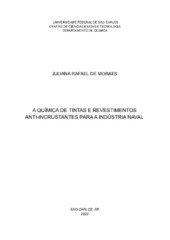| dc.contributor.author | Moraes, Juliana Rafael de | |
| dc.date.accessioned | 2023-02-16T19:05:37Z | |
| dc.date.available | 2023-02-16T19:05:37Z | |
| dc.date.issued | 2022-12-21 | |
| dc.identifier.citation | MORAES, Juliana Rafael de. A química de tintas e revestimentos anti-incrustrantes para a indústria naval. 2022. Trabalho de Conclusão de Curso (Graduação em Química) – Universidade Federal de São Carlos, São Carlos, 2022. Disponível em: https://repositorio.ufscar.br/handle/ufscar/17396. | * |
| dc.identifier.uri | https://repositorio.ufscar.br/handle/ufscar/17396 | |
| dc.description.abstract | This Final Paper makes a brief review of the main A/F paints and coatings for ships
and vessels, the main protection material against marine biofouling that affects world trade as
a whole. Different types of A/F paints have been developed and improved over the years, the
first protection techniques originated from ancient peoples such as the Phoenicians, using
natural oils and resins mixed with antifouling agents. The complexity of the marine
environment and the processes that make up biofouling have led to these coatings being
improved. Modernly, the protection of vessels started to consist of systems based on synthetic
polymeric matrices, such as self-polishing paints with biocides derived from organotin
compounds that revolutionized the industry in this segment. However, the concern with the
environment brought new challenges to the market, when in 2003 the use of organotin agents,
the most used agent in the formulations of paints and A/F coatings, was banned, due to the
irreparable environmental damage caused by these compounds. Nowadays, the search for
new coating technologies that address different effective protection mechanisms and biocidal
agents that are less harmful to the environment are topics of research worldwide | eng |
| dc.description.sponsorship | Não recebi financiamento | por |
| dc.language.iso | por | por |
| dc.publisher | Universidade Federal de São Carlos | por |
| dc.rights | Attribution-NonCommercial-NoDerivs 3.0 Brazil | * |
| dc.rights.uri | http://creativecommons.org/licenses/by-nc-nd/3.0/br/ | * |
| dc.subject | Tintas e revestimentos | por |
| dc.subject | Indústria naval | por |
| dc.subject | Polímeros | por |
| dc.subject | Antiincrustração | por |
| dc.subject | Paints and coatings | eng |
| dc.subject | Shipbuilding | eng |
| dc.subject | Polymers | eng |
| dc.subject | Antifouling | eng |
| dc.title | A química de tintas e revestimentos anti-incrustrantes para a indústria naval | por |
| dc.title.alternative | The chemistry of antifouling paints and coatings for shipbuilding | eng |
| dc.type | TCC | por |
| dc.contributor.advisor1 | Silva, Caio Marcio Paranhos da | |
| dc.contributor.advisor1Lattes | http://lattes.cnpq.br/7793686262868668 | por |
| dc.description.resumo | O presente Trabalho de Conclusão de Curso faz uma breve revisão das principais
tintas e revestimentos A/F para navios e embarcações, principal material de proteção contra
a bioincrustação marinha que afeta o comércio mundial como um todo. Diferentes tipos de
tintas A/F foram desenvolvidas e aprimoradas ao longo dos anos, as primeiras técnicas de
proteção foram originárias de povos antigos, como os fenícios, com o uso de óleos e resinas
naturais misturados com agentes anti-incrustantes. A complexidade do ambiente marinho e
dos processos que compõem a bioincrustação fizeram com que esses revestimentos fossem
aprimorados. Modernamente, a proteção de embarcações passou a ser composta por
sistemas de proteção baseados em matrizes poliméricas sintéticas, como as tintas de auto
polimento com biocidas derivados de compostos organoestânicos que revolucionaram a
indústria desse segmento. Contudo, a preocupação com o meio ambiente trouxe novos
desafios para o mercado, quando em 2003 foi proibido o uso de agentes organoestânicos, o
agente mais utilizado nas formulações de tintas e revestimentos A/F, em virtude dos prejuízos
ambientais irreparáveis causados por esses compostos. Hodiernamente a busca por novas
tecnologias de revestimentos que abordam diferentes mecanismos de proteção eficazes e
agentes biocidas menos nocivos ao meio ambiente são temas de pesquisas no mundo todo. | por |
| dc.publisher.initials | UFSCar | por |
| dc.subject.cnpq | ENGENHARIAS::ENGENHARIA DE MATERIAIS E METALURGICA::MATERIAIS NAO METALICOS | por |
| dc.publisher.address | Câmpus São Carlos | por |
| dc.contributor.authorlattes | http://lattes.cnpq.br/2161130677318697 | por |
| dc.publisher.course | Química - Q | por |

